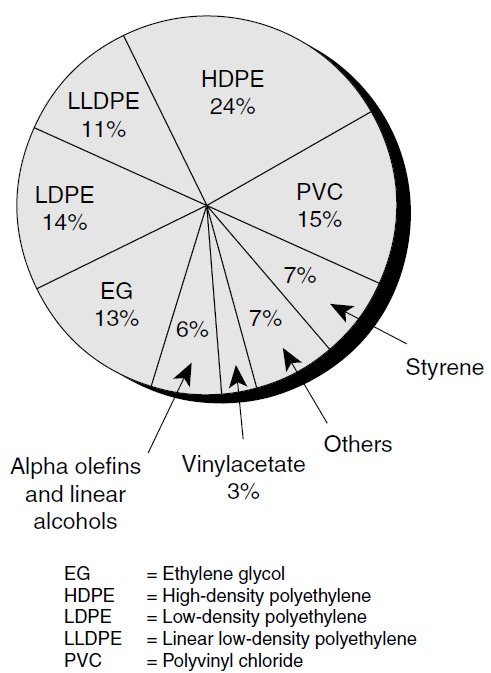
Chemicals Based on Ethylene
 المؤلف:
sami matar & Lewis. F. Hatch
المؤلف:
sami matar & Lewis. F. Hatch
 المصدر:
Chemistry of PETROCHEMICAL PROCESSES
المصدر:
Chemistry of PETROCHEMICAL PROCESSES
 الجزء والصفحة:
p 188
الجزء والصفحة:
p 188
 22-8-2017
22-8-2017
 1773
1773
Chemicals Based on Ethylene
Ethylene is sometimes known as the “king of petrochemicals” because more commercial chemicals are produced from ethylene than from any other intermediate. This unique position of ethylene among other hydrocarbon intermediates is due to some favorable properties inherent in the ethylene molecule as well as to technical and economical factors. These could be summarized in the following:
• Simple structure with high reactivity.
• Relatively inexpensive compound.
• Easily produced from any hydrocarbon source through steam cracking
and in high yields.
•Less by-products generated from ethylene reactions with other compounds than from other olefins.
Ethylene reacts by addition to many inexpensive reagents such as water, chlorine, hydrogen chloride, and oxygen to produce valuable chemicals. It can be initiated by free radicals or by coordination catalysts to produce polyethylene, the largest-volume thermoplastic polymer. It can also be copolymerized with other olefins producing polymers with improved properties. For example, when ethylene is polymerized with propylene, a thermoplastic elastomer is obtained. Figure 1.1 illustrates the most important chemicals based on ethylene.

Figure 1.1. Major chemicals based on ethylene.
Global demand for ethylene is expected to increase from 79 million tons in 1997 to 114 million tons in 2005.1 In 1998, the U.S. consumption of ethylene was approximately 52 billion pounds. Figure 1.2 shows the breakdown of the 1998 U.S. ethylene consumption.

Figure 1.2. Breakdown of U.S. 1998 ethylene consumption of 52 billion lb
 الاكثر قراءة في البترو كيمياويات
الاكثر قراءة في البترو كيمياويات
 اخر الاخبار
اخر الاخبار
اخبار العتبة العباسية المقدسة


